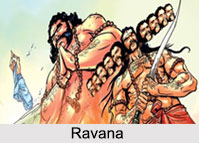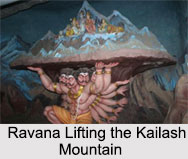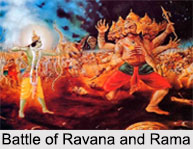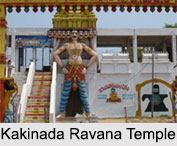 Ravana was the mythical multi-headed demon-king of Lanka in Hindu mythology, with ten heads and twenty arms. He could change into any appearance he wished, representing the very soul of evil. Ravana, the king of Lanka was the principal adversary of Rama in the great epic Ramayana. Ravana was also the king of rakshasas or demons. Ravana, a follower of Lord Shiva, has been depicted and illustrated as a great intellectual, an able ruler and a maestro of veena. His supreme ambition was to dominate the devatas. His ten heads stand for his knowledge of the six shastras and the four Vedas.
Ravana was the mythical multi-headed demon-king of Lanka in Hindu mythology, with ten heads and twenty arms. He could change into any appearance he wished, representing the very soul of evil. Ravana, the king of Lanka was the principal adversary of Rama in the great epic Ramayana. Ravana was also the king of rakshasas or demons. Ravana, a follower of Lord Shiva, has been depicted and illustrated as a great intellectual, an able ruler and a maestro of veena. His supreme ambition was to dominate the devatas. His ten heads stand for his knowledge of the six shastras and the four Vedas.
Etymology of Ravana
The word "Rava?a" means the thriving conflicting of "Vaisrava?a" meaning "hear clearly". Both Ravana and Vaisrava?a, who are popularly known as "Kubera", considered to be patronymics derived as sons of Vishrava.
Birth of Ravana
Ravana"s father was a famous rishi, Vishrava, who himself was a son of Prajapati Pulastya, one of Brahma"s ten "mind-born" sons. He was born in "Devagana", as his grandfather Pulastya was one of the ten Prajapatis of Brahma. Ravana"s siblings include Vibhishana, Kumbhakarna and Ahiravana and a step brother Kubera, from whom he seized the Kingdom of Lanka.
Legends of Ravana
Ravana was not named so since birth. He was "Dashanana". Ravana in order to please his mother had decided to get the mountain Kailasa to Lanka. As he lifted up the mountain, Lord Shiva was infuriated by his arrogance and pushed it back down, trapping Ravana and pressed the mountain with his toe crushing Ravana`s forearms. As Ravana let out blood-curling screams in suffering, he came to be known as "Ravana". It was then that Ravana became one of the supreme devotees of Lord Shiva. In another story, it is believed that to satisfy Shiva, Ravana slashed his own head into pieces, but his dedication made each piece spawn into another head. According to the myths, Ravana had killed King Anaranya and while dying, King Anaranya had cursed Ravana saying that the son of King Dasartha will in the end kill him. Ravana had also tried to kill the monkey king Bali.
Rama had praised Ravana as a "Mahabrahmin" and therefore had to perform "Ashwamedha Yagna" to kill Ravana. Ravana performed the beginning puja for the bridge building by Rama and his army of monkeys. He also blessed him, as he was only close to the most academic Pandit existing. Ravana was not only an amazing fighter, but also an expert of the Vedas and a specialist in astrology. Ravana`s empire spread over Balidweepa (Bali), Malayadweep (Malaysia), Angadweepa, Varahdweepa, Shankhadweepa, Yavadweepa, Andhralaya and Kushadweepa. It is believed that when his son Meghnada was to be born, Ravana instructed all the planets and Sun to be in their appropriate position for the fortunate "lagna" so that his son would become eternal. Saturn unexpectedly changed its location and then Ravana attacked Saturn with his stick and broke off one of its legs, injuring him for life.
Ravana is considered as the most holy follower of God. He is believed to have pleased Shiva with self-punishment to an extent where Shiva handed over an Atma Lingam (Soul of Shiva) as a boon to Ravana. Atma Lingam helped Ravana to achieve immortality and invincibility. Atma Lingam remained in Ravana"s control. He was defeated by Bali, beaten and imprisoned in his armpit for 6 months. It is believed that Ravana had a dedicated interest in music and was a highly talented veena player.
Battle of Ravana and Rama
 According to the myths, Ravana brought Rama`s wife Sita to precise revenge on Rama and his brother Lakshmana for having cut off the ears and nose of his sister Surpanakha. Surpanakha fell in love with Rama, and attacked Sita in vengeance. Lakshmana was the first to act in response, cut off the ears and nose of Surpanakha. She convinced Ravana that Sita was a girl worth fighting for.
According to the myths, Ravana brought Rama`s wife Sita to precise revenge on Rama and his brother Lakshmana for having cut off the ears and nose of his sister Surpanakha. Surpanakha fell in love with Rama, and attacked Sita in vengeance. Lakshmana was the first to act in response, cut off the ears and nose of Surpanakha. She convinced Ravana that Sita was a girl worth fighting for.
Ravana kidnapped Sita, taking her back to Lanka in his aerial chariot. Rama chased Sita along with Lakshmana. Then Rama asked for help to Sugriva, monkey king and he got the help of Sugriva"s general Hanuman and his army. Hanuman magically transported Rama and his force to Lanka, crossing the rock bridge built by the expert general Nala, which became known as Rama"s Bridge. After reaching to Lanka, in an epic battle Rama defeated Ravana. Ravana was dead. He was given an appropriate funeral and his body burnt according to proper custom.
Depiction of Ravana
In Valmiki"s Ramayana, Ravana has been depicted as a dictator of powerful powers and he continues to be treated as a blackguard in India even now. Ravana is generally depicted multi-headed and multi-armed, carrying all manner of deadly weapons. His body was covered in scars, won in infinite battles with the gods. Three wounds were from of Vishnu, the thunderbolt of Indra, and the tusk of Airavata, the elephant of Indra. In Bhagavata Purana, Ravana and his brother Kumbhakarna were mentioned as the incarnations of Jaya and Vijaya, the two gatekeepers of Vaikuntha, abode of Vishnu. In Buddhism, Ravana is a major character in Buddhist texts such as the "Lankavatara Sutra" and the "Gathering of Intentions", a text of the Nyingma school of Tibetan Buddhism. In the Thai text "Ramakien", an epic influenced by the Ramayana, Ravana is a "yaksa" or a "rakshasa". According to the Jain description, both Rama and Ravana were religious Jains.
Ravana in Art
Ravana appears in the attractive sculpture of Hindu temples. In a famous relief scene on the 8th century Kailasanatha temple at Ellora, Ravana is revealed shaking the sacred Kailasa Mountain. Scenes from the Ramayana relating Ravana were also very popular from the 16th century in Indian watercolours, particularly esteemed are those from Udaipur and the Pahari paintings.
Temples of Ravana
 There are several temples in India where Ravana is worshipped. These are Ravana Mandir Bisrakh (Uttar Pradesh), Koteshwar Temple Gujarat, Dashanan Ravana Temple (Kanpur), Jodhpur Ravan Mandir (Rajasthan), Ravangram Ravana Temple (Madhya Pradesh) and Kakinada Ravana Temple (Andhra Pradesh).
There are several temples in India where Ravana is worshipped. These are Ravana Mandir Bisrakh (Uttar Pradesh), Koteshwar Temple Gujarat, Dashanan Ravana Temple (Kanpur), Jodhpur Ravan Mandir (Rajasthan), Ravangram Ravana Temple (Madhya Pradesh) and Kakinada Ravana Temple (Andhra Pradesh).
Worship of Ravana
According to Ramayana, Ravana was the son-in-law of Mandsaur, Madhya Pradesh. He is worshipped for his supreme knowledge and religious dedication to Lord Shiva. The place also has a 35 feet tall statue of Ravana. On Dussehra, people express grief for the death of Ravana and hold prayers. Bisrakh, Uttar Pradesh is the birthplace of Ravana and he is considered as maha-brahman here. People perform "yagnas" and prayers for Ravana"s death in the Navratri festival. Gond Tribals of Maharashtra worship Ravana and his son Meghnada as Gods during a tribal festival - Falgun. Ravana is worshipped at Kangra, Himachal Pradesh also as it is believed that Lord Shiva granted him his boon here. In Lankadipathi festival, Ravana is worshipped by people of Kolar District in Karnataka. Maudgil Brahmans of Jodhpur, Rajasthan worship Ravana as Ravana"s marriage performed at Ravan Kin Chanwari at Mandore.



















